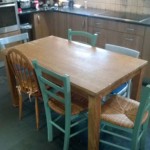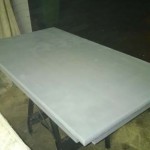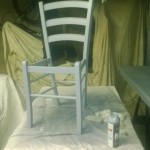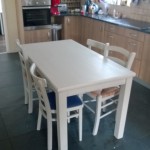Gone are the days in which weÔÇÖd throw perfectly good furniture into a skip and replace it with a brand new buy. With purse strings getting tighter and crafty TV shows making it fashionable again to make do and mend, these days itÔÇÖs all about ÔÇÿupcyclingÔÇÖ. And it doesnÔÇÖt get much easier than transforming the good old kitchen table into a centrepiece to be proud of! HereÔÇÖs how:
 1. If you have space in a garage or workshop, move your table and chairs from the kitchen into the workspace. If not, place them on top of dust sheets or newspaper.
1. If you have space in a garage or workshop, move your table and chairs from the kitchen into the workspace. If not, place them on top of dust sheets or newspaper.
2. Strip the table back to bare wood using a biodegradable paint remover, which is less toxic than older paint strippers and does not smell as strong.
3. Sand the wood thoroughly and wipe down with a clean cloth.
 4. Apply a coat of paint. ItÔÇÖs likely youÔÇÖll need to re-sand the wood after the first coat before applying a second coat.
4. Apply a coat of paint. ItÔÇÖs likely youÔÇÖll need to re-sand the wood after the first coat before applying a second coat.
5. Wax with a cloth and remove any residue with a second, clean cloth.
6. If youÔÇÖre also repainting the chairs, itÔÇÖs wise to remove drop-in seats before you get started. You might need to unscrew them first and perhaps gently tap out tightly fitted seats with a hammer from below.
 7. Treat loose joints and splits with wood glue. Check thoroughly for small, neat holes, which are a tell-tale sign of woodworm, and treat if necessary with woodworm solution or spray.
7. Treat loose joints and splits with wood glue. Check thoroughly for small, neat holes, which are a tell-tale sign of woodworm, and treat if necessary with woodworm solution or spray.
8. Sand, apply a coat of paint and repeat if necessary, as above.
9. Re-fit the drop-in seats. For a completely new look you can re-cover the foam first with a fabric of your choice or, if they are particularly old and worn, you can buy new foam and cut to the right size using the old seats as a template.
 10. Hey presto, you have a lovely ÔÇÿnewÔÇÖ dining set!
10. Hey presto, you have a lovely ÔÇÿnewÔÇÖ dining set!
 Did you know?
You can paint the wood in a number of different ways, to suit the type of furniture and the style of the room it sits in:
Distressed wood: Get the shabby chic look by applying two coats of paint, waxing and sanding back the wood gently.
Wood wash: Dilute the paint with water then apply as normal for a softer, translucent finish that highlights the wood grain. This works particularly well when whitewashing or lime-washing furniture or floorboards.
Crackle-glazed finish: Dry the paint with a hairdryer and wax with a clear then a dark wax, which will run into the cracks.


 Popular DIY retailer Homebase is to lose a quarter of its stores following a business review. One in four of the chainÔÇÖs 323 outlets will close by 2018, having been branded ÔÇÿunprofitable or in declineÔÇÖ.
Popular DIY retailer Homebase is to lose a quarter of its stores following a business review. One in four of the chainÔÇÖs 323 outlets will close by 2018, having been branded ÔÇÿunprofitable or in declineÔÇÖ.

 For people who are good at managing their money, a 0% credit card can be an excellent way of financing a building or DIY project. As the name suggests, these cards offer interest-free credit for a specified length of time and, with a recent credit card ÔÇÿwarÔÇÖ breaking out between lenders, itÔÇÖs a great time to take advantage of 24 and even 32-month 0% deals. But remember that the trick here is to switch to another 0% free card when your deal comes to an end or you could find yourself on an unfavourable rate without realising the costs.
For people who are good at managing their money, a 0% credit card can be an excellent way of financing a building or DIY project. As the name suggests, these cards offer interest-free credit for a specified length of time and, with a recent credit card ÔÇÿwarÔÇÖ breaking out between lenders, itÔÇÖs a great time to take advantage of 24 and even 32-month 0% deals. But remember that the trick here is to switch to another 0% free card when your deal comes to an end or you could find yourself on an unfavourable rate without realising the costs.